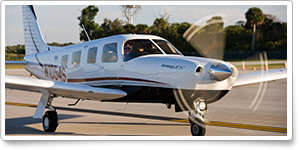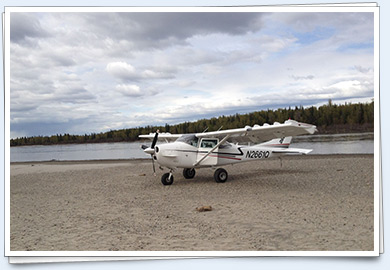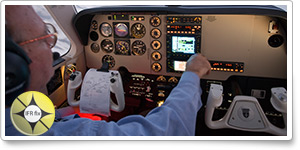| ||||||
| Cool in the climb |
| |||||
Training TipsCool in the climb After climbing initially at best rate to a safe altitude, you jotted down your takeoff time, and calculated an estimated time and distance to level off. Now all that remains is to maintain your on-course heading, keep tabs on the altimeter, and watch for that first checkpoint to appear. Well, there is more to it than that. That long climb requires a lot of attention, both for collision avoidance and to keep your aircraft’s engine from overheating. As you climb, lower the nose at regular intervals for better forward visibility. Check to the sides as well. Raise each wing momentarily and give the area a thorough scanning. Lowering the nose has the added benefit of increasing air flow through the engine cowling, which should help control the temperature of an air-cooled aircraft engine. If it is a hot day, keep a close check on engine oil temperature (or cylinder-head temperature if so equipped) during the climb—especially if extended engine operation on the ground preceded your takeoff. If engine temperature is abnormally high, try a higher climb airspeed. Remember that an excessively lean fuel-air mixture can raise engine temperatures beyond recommended limits. Monitor outside temperatures at altitude on your outside air temperature gauge, and expect reduced climb performance as altitude increases. At 20 degrees Celsius and 8,000 feet, a 1978 Cessna 172N at gross weight produces a 335-foot-per-minute climb rate, compared to a 650-fpm climb rate at 20 degrees Celsius and 2,000 feet, according to the pilot’s operating handbook. The aircraft’s POH recommends climbing at speeds five to 10 knots higher than best rate of climb speeds “for the best combination of performance, visibility, and engine cooling.” What does your aircraft's POH recommend? It may also have specific advice about leaning, including a recommended altitude for beginning that process (3,000 feet for the Cessna 172N). The busy time immediately after takeoff can be hectic as you depart the local airport area and establish your flight on course. Make sure to include engine management and collision avoidance on your list of piloting tasks for this critical phase. Flight Training NewsEmbry-Riddle takes national Safecon championshipEmbry-Riddle Aeronautical University's Prescott, Ariz., campus won the National Intercollegiate Flying Association's 2012 Safety and Flight Evaluation Conference (Safecon), held May 14 to 19 at Kansas State University. Teams participate in flying contests, and colleges earn points toward the top award for each student who places in an event. The University of North Dakota came in second, and Southern Illinois University was third. In fourth place was Western Michigan University, and in fifth was The Ohio State University. A complete list of rankings can be found on the NIFA website. Boeing chief test pilot calls for training overhaulWith both the commercial and general aviation communities facing a pilot shortage, it’s imperative that the industry overhaul its training efforts, according to Boeing’s test and evaluation chief pilot for new airplane development. Mike Carriker says training needs to catch up with advances in aircraft and technology. Read more >> Air Force kicks oldest GA club off baseMore than a half-century after its formation, the flying club at Wright-Patterson Air Force Base in Dayton, Ohio, is packing up for departure. The club, which has approximately 300 members, will continue as a purely general aviation group at nearby Greene County-Lewis A. Jackson Regional Airport. Read more >> Are you paying attention to density altitude?As summer approaches and the days become hotter, density altitude should become a higher priority in your preflight planning. But what exactly does density altitude mean, and why should you pay attention to it? It can't be seen, heard, or felt, but it can be measured and it will affect your flights. Check just how well you grasp the concept of this invisible killer with the Air Safety Institute’s Density Altitude safety quiz, underwritten by the AOPA Insurance Agency. Take the quiz >> Mind your heading and attitude systemYour flight instructor may have explained the aircraft pneumatic system, but do you recall how it works? Here's a quick refresher with the Air Safety Institute’s Pneumatic Systems online course. It explains the nuts and bolts of the pump, has animated operations schematics, and provides a real demonstration of how your situational awareness can be affected if the system fails in reduced-visibility flight (night VFR or IMC) without electrical backup. Training Resources
Join the active student pilot community at the Flight Training Facebook page, where you can share photos, discuss your training issues, and much more. Click “Like” today!
Did you know that student pilots who join AOPA are three times more likely to complete their flight training? Membership includes unlimited access to aviation information by phone (800/USA-AOPA, weekdays from 8:30 a.m. to 6 p.m. Eastern time) or from Flight Training Online or AOPA Online. If you’re not already a member, join today and get the pilot’s edge. Login information is available online. Rod Machado Career Pilot
Airlines’ seating fees may be scrutinizedSen. Charles Schumer (D-N.Y.) said he’ll ask the Department of Transportation to issue rules preventing airlines from charging higher fees for families with young children when purchasing seats together. Some airlines have increased the percentage of seats set aside for customers willing to pay extra. Fees vary for seats on the aisle or next to windows. Families who want to purchase seats together would typically end up paying the fees. Schumer said he would also call on industry trade group Airlines for America (A4A) to ask carriers to waive the fee for families, according to The Christian Science Monitor. Trade group forecasts record summer international travelAirlines for America (A4A), an industry trade association for U.S. airlines, said May 9 that passengers can expect full flights this summer, thanks in part to a record number of people traveling internationally and an improving economy. “Customers are benefiting from record airline operational performance and greater access to the global economy while fares continue to trail the price of other services,” said A4A President and CEO Nicholas E. Calio. The organization predicted that from June through August, U.S. airlines will carry an average of 2.24 million travelers globally every day, with total passenger volumes remaining 5 percent below the summer 2007 all-time high of 217.6 million. Plane Spotter
Piper Saratoga: Sleek single Training ProductsInteractive Practical Test StandardsAs you read this, the FAA has released a new version of the Private Pilot Practical Test Standards, effective June 1. The new version includes a new task, the emergency descent. If you haven't yet seen the new PTS, Gold Seal has you covered. The company has put together an interactive PTS that it is making available free of charge. The Flash-based PTS can be viewed on any computer with an Internet connection, and can be downloaded and viewed on an iPad with the use of the free Articulate Mobile Player app. Note: Products listed have not been evaluated by ePilot editors unless otherwise noted. AOPA assumes no responsibility for products or services listed or for claims or actions by manufacturers or vendors. Member BenefitsHonesty the best policy for medical applicationThe FAA takes alcohol- and drug-related offenses seriously—and failing to report an arrest, conviction, or administrative action involving a motor vehicle while under the influence on one’s next FAA medical examination will only compound the problem. Dr. Warren Silberman, former manager of FAA Aerospace Medical Certification, offers advice for pilots suspected of one of these offenses as part of AOPA’s Pilot Protection Services program. Read more >> BlogsLosing an engine in cruiseWhen you hear on the news that a commercial flight lost an engine in cruise, it may sound a little dramatic. Professional pilot Chip Wright says in real life such events are much more methodical. Also in the Flight Training blog, Technical Editor Jill W. Tallman says the weather and your schedule may be in sync, but a mechanical issue could put a stop to your flying plans in a hurry. An (extra)ordinary dayAOPA’s Kristen Seaman writes about aviation frequently for her job as communications coordinator. In this installment of the Let’s Go Flying blog, she gets to write about her own flying—specifically, her first solo. AOPA Career Opportunities
Ever dream of turning your passion for aviation into a career? We’re looking for a vice president of information systems; registration, housing, and meeting planner; aviation technical writer; member services representative; project manager of online products; and associate editor–Web/ ePilot. To learn more about other AOPA career opportunities, visit AOPA Online. Community
AVIATION EVENTS & WEATHER
| ||||||||||||||||||||||||||||||||||||




 You are airborne, cleared on course and climbing to cruise altitude. You flight-planned a higher cruise than usual today because of the jagged terrain that lies between here and your destination.
You are airborne, cleared on course and climbing to cruise altitude. You flight-planned a higher cruise than usual today because of the jagged terrain that lies between here and your destination.





